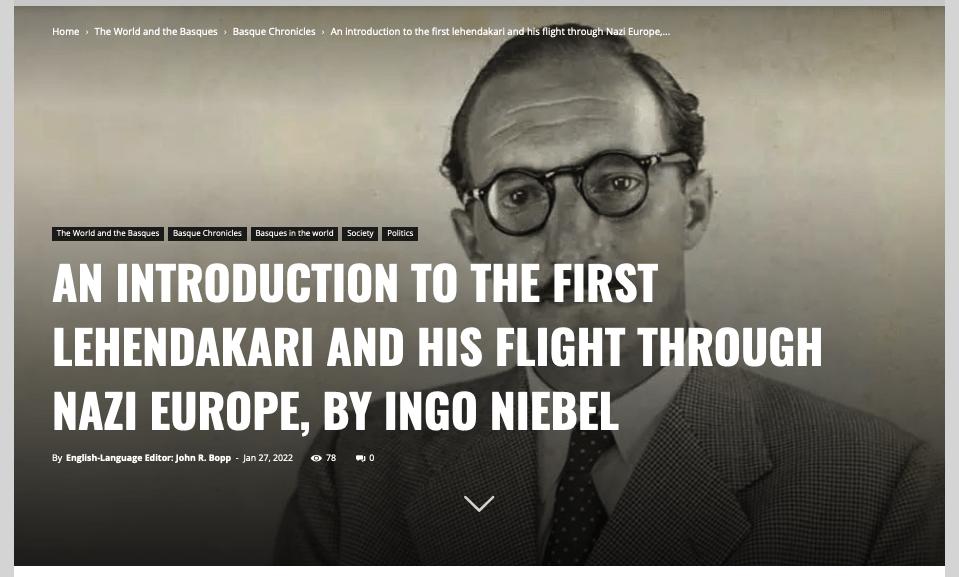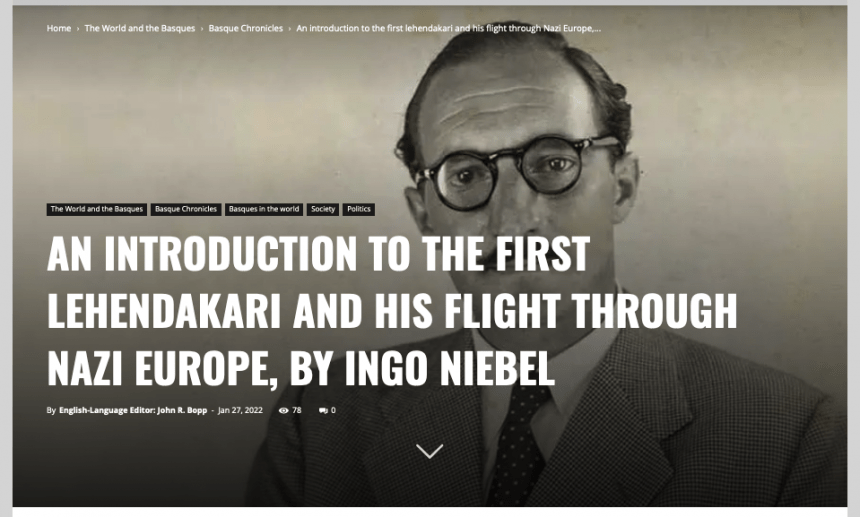
(Article published and translated by About Basque History. A Spanish version can be found here.) We live in a time when post-truth, with its fake news, which used to be called simply “lies,” has become a lethal threat for the Sciences, coexistence, and finally for each person’s life. Even so, only the Sciences can help us find solutions to our problems. One such Science is that of History, or Geschichtswissenschaft, as it’s called in German. Understanding the past helps us to understand the present and allows us to design a better future.
So far, so much theory, because post-truth also kidnaps history when its supporters think that they can write it to their liking without having to respect even the most basic rules of science, such as basing claims on sources. About fifteen years ago, a current began flowing that, to this day, is attempting to “nazify” both the first lehendakari, José Antonio Agirre Lekube, as well as his party, the PNV.
Doing so is free of charge or consequence. That’s why it’s so easy to paint the past so arbitrarily without going through the complicated work of the historian which, like the coroner, has to try to not contaminate the object of study so that, at the same time, he may gather this greatest amount of data. That’s why there are methods, which require time, and which may at times prove something unwanted. But that’s how Science works.
The “fugitive profile” and other scientific questions
In the case of the first lehendakari, we know that he managed to escape the German and Spanish police forces. Therefore, it is not a good idea to yet again retell that which is laid out in his autobiography, De Guernica a Nueva York pasando por Berlín and in his personal diary, which he wrote exclusively during his escape. The most important matter was to explain why Agirre managed to escape while two of his contemporaries, Catalan president Lluis Companys, and the ex-president of the Spanish Republic, Francisco Largo Caballero, didn’t. The Germans arrested them both, first at the behest of the Francoist police in 1940 and then on their own initiative in 1943. Companys was shot to death, while Largo Caballero was freed from the Sachsenhausen concentration camp. Moving over to another science, criminology, we can find research that gives rise to what could be called the “theory of flight” which in turn allows us to draw up a “fugitive profile”. If these techniques are applied to how Agirre carried out his escape, his success is better understood. And when one says “escape”, one also says “chase”, as that’s the other side of the same coin.
With this background, it wasn’t enough for me to verify the version Agirre offered in his autobiography and diary; I had to also explain how the Francoist and Nazi police systems worked, and the importance they gave to the lehendakari in particular and to “the Basques” in general. The data necessary for this was to be found in some works by other historians, but especially by going out and finding new sources.
One line of research was to find documents that backed up the existence of the Panamian attorney José Andrés Álvarez Lastra; that is, the false identity Agirre used between June 1940 and September 1941. I managed to find the Belgian foreign office dossier where he first signed his false name. I also found the files the Nazi secret police, the Gestapo, had written up about Agirre.
Unfortunately, much of that information was lost in the war in Germany; much more was seemingly lost in Spain as well, with the destruction of documentation carried out when the dictator died in 1975.
Given that Agirre returned to Berlin in 1956, where he had been in hiding for almost six months in 1941, I also included some aspects of the Cold War in the book. Moreover, Francoist police officer Pedro Urraca, who had chased him in 1940-1, was still causing the Agirre family problems in Belgium.
In addition to fact checking and adding new information, it is important to keep in mind the human dimension of the person one is researching. In this specific case, the behavior and internal balance of the fugitive made up a decisive factor in whether he would manage to escape or not. Later, the lehendakari wasn’t “the good guy” just because, but rather because there was at least one “bad guy”. Agirre’s human character stands out when his facts and thoughts are contrasted with those of Nazi Propaganda Minister Joseph Goebbels. The latter would also leave behind a diary for posterity. Since he was also a regional leader in Berlin, it is interesting to see how, for example, he organized a tobacco shortage that passionate smoker Agirre later lamented upon in his own diary. The moral abyss that separated them can be seen by comparing their comments regarding the death of the former Spanish king, Alfonso XIII.
The $64,000 question is why it was necessary to dig so deep into Agirre’s flight. Here we come up against the controlled subjectivity without which there can be no objectivity.
From controlled subjectivity to objectivity
I found his autobiography in the library about Basque topics that my father, Klaus, had filled up ever since he spent a year working in Guernica in 1960-1. The friendships he made at that time showed him that behind the gold-and-red flag and yoke and arrows that adorned it, there was another hidden political, cultural, and linguistic reality. Upon returning to Germany, he decided to eradicate ignorance of what the Basque Country is by gathering as much information as he possibly could about that enigmatic country, people, and language that officially shouldn’t exist. In 1975, my parents decided to spend their holidays in Guernica. Before leaving Cologne, he told me, “Guernica was bombed, and it was by the Germans.” At the age of nine, I was surprised mostly by the fact that he didn’t sugar-coat it or prep me for it, breaking my family’s taboo about discussing the time of the Nazis and the war. I asked him for a book in German, with photos, about the bombing, and he told me they didn’t exist yet. He also explained that there were people who still said the destruction had been the work of the Basques themselves.
My childhood curiosity later became my academic and journalistic interest. Since my childhood, I’ve lived in that space between the distorted image the German press painted of the Basque Country (a term which at the time extended to all seven Basque provinces) and the reality I lived while staying there, which grew more frequent as I grew up. Then, at university, I came across to the realization that there was absolutely no questioning at all of the focus given Basque topics in History, Language, or Political Science if it came from a Spanish point of view. However, if one started from within the “Basque labrynth”, the professors, content to have a proposal that was so distinct from the regular ones, would approve the research, but with the tag, “make sure it’s academically founded and not a separatist pamphlet.” These demands put me on the defensive against the Spanish academic hegemony that was understood to be “normal” and per se scientific, despite having been propped up by a dictatorship. Accepting these rules, I learned to really strengthen my positions with excellent arguments. This, of course, included studying the opposing arguments very well, in order to find their weak points.
When, in the ’90s, I decided that my final thesis would be about the Basque Government during the Spanish Civil War, I knew that first, I would have to back up the veracity of everything said and done by Agirre before being able to cite him as a reliable source. Not only was he Basque; an additional aggravating circumstance was that a few years prior, the scandal of Hitler’s false diaries had cost journalists and historians quite a lot of credibility. Because of that, any personal source, be they diaries or memoirs, were under a general suspicion of potentially being fake.
So the fact that, in the end, it took me almost three decades to finish this project, is not only due to scientific rigor, but also to the fact that in 1940-1, Agirre did not want to be found. Thus, he kept a low profile, Inded, many of the absolutely necessary documents to understand his escape appeared slowly, gradually, and the most important ones, only in the last year.
From coherence to credibility
The study of this existential chapter of his life allows us to understand the respect his contemporaries had for him. I think a large sector of Basque-Navarrese society is unwilling to follow a “leader”: If a person is granted that special position, it’s because that person has gained the people’s respect thanks to his or her consistency, the basis for credibility. Agirre showed that consistency, because he never switched sides or threw in the towel, despite everything he had to live starting in 1936, when he had to take over the political and military responsibility in a war that was far removed from his politics and ideology. In 1940-1, he did not fall into the temptation to become a satellite state under Nazi suzerainty. He remained true to his anti-fascist positions all the way to his premature death in 1960.
Though he lost in the military and international political spheres to Franco’s regime, his credibility was worth more. He inspired some to follow his example, while for others he was a guiding point, even if they were being guided in the other direction. Agirre was convincing thanks to his way of being. What’s more, is how biography proves that, when the time comes, an individual is able to put into practice what had until then been a utopia or mere political project. He himself did so on October 7, 1936, when, under the Tree of Guernica, he swore his oath, transforming the idea of “Euzkadi” into a real institution. From that moment on, he never ceased to be the lehendakari, not even under an assumed identity.
All this is better told if the research and its methodology and the debate about the works of other researchers are separated from the presentation of the data it contributes. The data about an unexpected escape has been summarized in the first part. There, I have elected to omit footnotes and the inevitable debate between academics about the sources used. All my information that make the study verifiable and therefore scientific can be found in the second part of the book, in the “making of”, also written in a friendly style.
With this different way of presenting a research paper, I want to help improve communication between “my” Science of History and the readership interested in this topic. This step is necessary for Science to win—in this case with historical truth—over post-truth.


